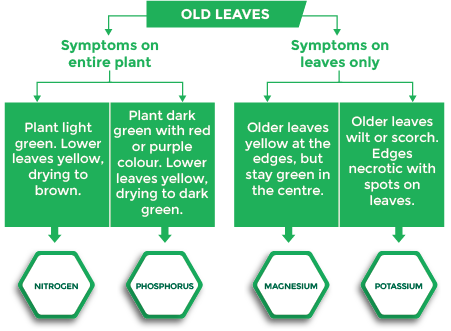Nutrient Deficiency – Symptoms and Solutions
Crops require essential nutrients for healthy development and optimal growth. Various physiological functions such as photosynthesis, nutrient uptake, root growth and flowering all rely on nutrients. When plants don’t have enough of a specific nutrient they may display a range of symptoms, varying from morphological impairments (i.e. stunting), to chlorosis or necrosis, to premature seed set and ripening.
Deficiency in any given nutrient comes with the presentation a specific symptom or combination of symptoms. The expression and severity of symptoms varies, depending on how long the crop is left deficient.


Deficiencies can occur even when the nutrient is in optimal supply if there are other factors like waterlogging, which can affect the soil’s ability to transfer the nutrient or the plant’s ability to access it. For example, high pH levels in soil restrict availability of zinc, copper, manganese and iron, and dry top soil can limit the uptake of calcium and boron early in the season.
When correcting nutrient deficiencies, you should keep in mind that interactions between nutrients can influence uptake. Too much of one nutrient can restrict the crop’s ability to take in another. If your crop is displaying potassium deficiency symptoms, it may indicate a shortage of potassium, but it may also be related to over application of nitrogen, calcium or magnesium, or it may also be caused by saline soil.
In saline soils, crops can take in excess chloride, which greatly reduces phosphorus uptake. Likewise, high potassium and/or calcium often trigger magnesium deficiency in plants. If there is too great an abundance of certain nutrients in the soil, a crop may also turn on its natural toxicity prevention mechanisms, which could lead to reduced nutrient uptake.
Although abiotic and biotic stresses are the biggest causes of nutrient deficiencies, some practices used on the farm can contribute a great deal. Compaction seen this past fall with the late harvest in wet conditions is likely going to induce early-season deficiency of potassium. The chemistries used to control weeds, diseases and pests also have chelating properties that prevent crops from accessing certain nutrients at critical times.
In addition, some weed species are very competitive, sequestering key nutrients from the root zone and preventing crops or their beneficial microbes from accessing them.
The way crops deal with deficiency depends on whether the nutrient is mobile or immobile in the plant. If the nutrient is mobile, like nitrogen, phosphorus or magnesium, the plant can ‘strip it’ from the old leaves to protect the younger growth and reproductive organs. However, if it’s immobile like calcium or boron, deficiency will occur throughout the entire plant.
Choosing a foliar fertilizer is an excellent way to supply crops with necessary nutrients and to prevent or correct deficiencies. OMEX foliars are developed with balanced NPK formulations with key secondary nutrients and a full micronutrient package, which is often better than highly concentrated solutions of single elements, especially when the cause of deficiency is not clearly identified.
OMEX offers a wide range of foliar solutions for deficiencies prone to occur in Western Canadian crops. To help you pinpoint the real cause of deficiencies when they occur, OMEX offers an SAP analysis to correlate the results of soil tests and tissue tests. Call your OMEX representative for a guided deficiency diagnosis and a nutrient management strategy.
| Visible Deficiency |
Cause by an Excess of |
|---|---|
| Potassium | Nitrogen, calcium, magnesium, sodium |
| Magnesium | Potassium and/or calcium |
| Nitrogen | Chloride |
| Sulfur | Chloride |
| Calcium | Magnesium, potassium |
| Boron | Calcium |
| Iron | Nitrogen, phosphorus, manganese, molybdenum, nickel, zinc, bicarbonate |
| Manganese | Phosphorus, iron |
| Copper | Phosphorus, molybdenum |
| Zinc | Phosphorus |

